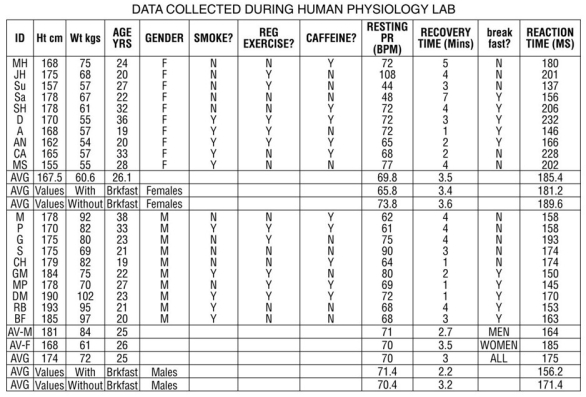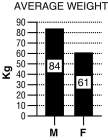Following is a table of data collected from one section of an 8 a.m.physiology lab.There were 20 students present, 10 men and 10 women.Information collected from the students included their height, weight, age, gender, and resting pulse rate.In addition, the students were surveyed to see if they smoked cigarettes, considered themselves "regular exercisers," if they had consumed caffeine the morning of the lab, and if they had eaten breakfast that day.A "y" or "n" (yes or no) was recorded to indicate their answers.Each student did "jumping jacks" for 5 minutes and recorded the time required to regain their resting heart rate, which is listed on the table as "recovery time." Finally, each student participated in an exercise designed to measure their reaction time (in milliseconds) in catching an object dropped by a lab partner according to specified criteria.Use this table to answer the following questions.Ignore statistical problems caused by small sample size, and so on.

Table 1.3

Figure 1.3
For these questions, the data were separated and analyzed by gender.
-Refer to Table 1.3.
A.Write a hypothesis regarding the effects of breakfast consumption on reaction time.
B.What is the dependent variable? What is the independent variable?
Definitions:
Linguistic Style
The distinct manner or pattern of speech and language usage that characterizes an individual, group, or context.
Fear-Arousing
A communication strategy designed to elicit fear in order to influence attitudes or behaviors.
Cognitive Dissonance
The mental discomfort experienced by an individual who holds two or more contradictory beliefs, values, or ideas at the same time.
Attitude Change
The process in which an individual's feelings, beliefs, or behavioral intentions toward an object, person, or situation are modified.
Q14: As the amount of glucose is limited,
Q47: The FDA regulates direct, but not indirect,
Q55: As people age, they tend to lose
Q62: For each of the labels on this
Q76: Which of the following is NOT a
Q86: _ generated in the _ enter the
Q95: The term secretion refers to<br>A) the process
Q104: Ahmed is trying to memorize chemical structures
Q115: For the following strand of DNA, use
Q135: What are the five ways that cells